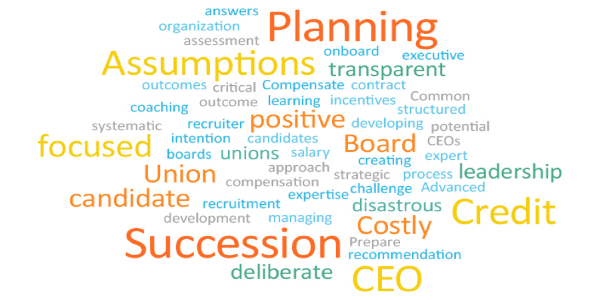Succession planning is a current and critical initiative for many credit unions. Over 1200 CEOs will transition in the next four years. Over the past few years, I have seen various succession planning outcomes for many credit unions as well as other outcomes somewhat disastrous because of a lack of a deliberate and focused planning process. I write this short article to, hopefully, challenge some readers to check their assumptions and blind spots (we all have them) before embarking on a process that could result in unintended collateral damage rather than a more positive outcome of a structured and systematic process.
Here are 8 common assumptions that tend to be blind spots for boards and CEOs in CEO succession planning:
1) Assumption: Internal candidates are ready for the CEO role.
Solution: Prepare a detailed baseline of required skills, expertise, and leadership attributes. Conduct a gap analysis to better understand if internal candidates are ready.
2) Assumption: They applied for the CEO job, so they’re ready, and no onboarding is needed.
Solution: Many candidates come from larger credit unions and leave because they want to be a CEO. Skills, expertise, and leadership are at a point to be applied in a CEO role. Boards that dismiss the notion of an onboarding process lose sight of the fact that they are responsible for supporting the success of the new CEO. Hence, give the new CEO an on-ramp to success with onboard executive coaching.
3) Assumption: An external candidate will be the best CEO, and, therefore, we don’t even need to bother to include potential internal candidates.
Solution: An external candidate might be a better fit, yet if the internals are not included or invited in the conversation, the board is creating unnecessary chaos that ends in low morale and a more challenging onboarding for the new CEO.
4) Assumption: Wait until the CEO actually leaves before starting the process.
Solution: Start years in advance so the transition is with ease and the change is transparent. Advanced planning by the board can start as soon as ten years and, ideally, no less than three years.
5) Assumption: The CEO does not need to be involved with developing internals.
Solution: The CEO creates development plans for the internals so there is focused learning and development.
6) Assumption: Signing a recruitment contract is succession planning. This is one of the worst assumptions a board can make. A recruitment contract is NOT succession planning; it is a singular episodic event.
Solution: Succession planning is a systematic planning process with feedback loops. It is ongoing and becomes part of the DNA of the organization when designed and implemented with intention. If you are 6 – 9 months within needing a new CEO, then sign a recruitment contract, as it is too late for strategic succession planning.
7) Assumption: A recruiter is an expert in succession planning. This is a misguided assumption because a succession planning consultant has expertise in organization development, career development, and strategic planning and understands how to design and implement a system involving humans. A recruiter knows how and where to find the best candidates.
Solution: Work with a subject matter expert in succession planning as a strategic partner. The subject is complex and has opportunity for far-reaching positive impact far beyond a singular recruitment event.
8) Assumption: Compensate the new CEO less than the current CEO.
Solution: Such an approach to compensation is misguided. First of all, is your current CEO compensated at today’s market rates? How do you know? In the compensation studies we do, less than 50% are compensated at the same level for which you would need to recruit from the outside. So, update compensation now by looking at base salary, short- and long-term incentives, and benefits. If you use a subject matter expert to assess compensation levels, ask if he or she also invests and manages these long-term rewards. I prefer a separation of assessment and recommendation from the management of such funds.
Many credit unions are managing succession planning with a positive and strategic approach. I hope this article answers questions for those who are just beginning. The sooner you start the conversation, the more options you have to consider.







